Environment Setup
Table of contents
Overview
This section helps you set up a working environment for this text. Through this process you will install and verify your development environment.
If everything goes well, this should only take about 20 minutes. However, it is very normal to encounter issues if you are not used to this workflow. Don’t worry, you will be an expert soon!
Making web applications is complicated, so it is critical that your environment’s setup and the eventual structure of our web application follow these instructions precisely. If this seems limiting, that’s the point. Please try to stay within the bounds given as you experiment and try things out!
Do not skip steps.
Read error messages, and ask questions. Talk to humans as needed to get help, and use Google intelligently.
Get Software
Get VSCode
Download Visual Studio Code
VS Code is an IDE (Integrated Development Environment) that you will program in.
When you have VS Code downloaded, open the application. You will need to install two extensions.
To open the extension menu, you can type Ctrl+Shift+X (Windows) or Cmd+Shift+X (Mac). There is also a navigation bar on the left side of your screen and you can click the extensions menu that looks like this:
![]()
A search bar will appear at the top of the menu. Type ESLint and click “install”:

Then, search for Prettier and click “install”:

Make sure you have installed the extensions that are in the images above. These are the correct versions!
Get Node
Next, download and install Node
You should use the installer for the most recent LTS version. The link will take you to the correct download page.
Once you have downloaded the installer, open it.

You may notice that it is installing both Node and something called npm. Node Package Manager (npm) will make it easier to manage, install, and update node packages. You need both of these.
The installer will ask you to select where you want to install the package; keep the default location that already appears.
- For Windows:
C:\Program Files\nodejs - For Mac:
/usr/local/bin/node
Once the installer is finished, you should see this screen:
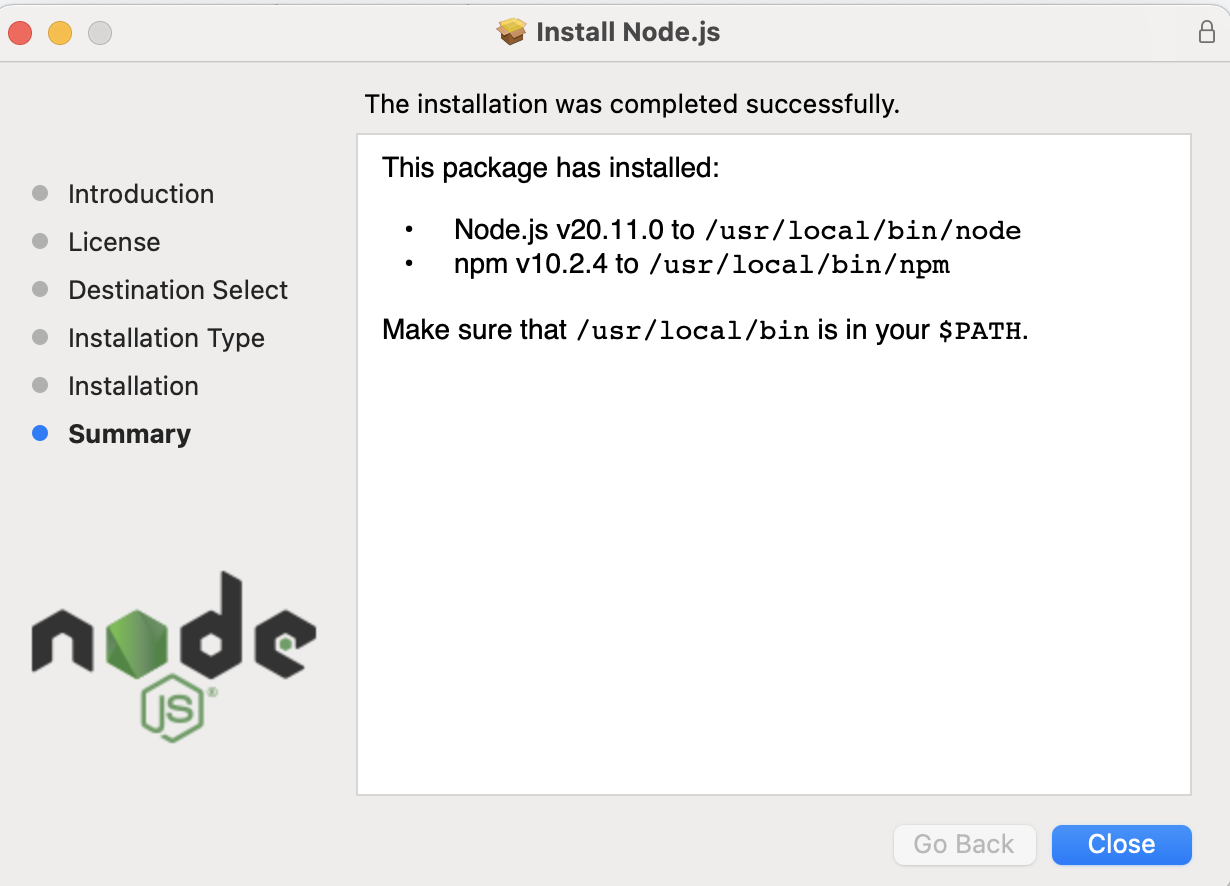
Now we need to verify that the installation was successful. Navigate back to VS Code and open a terminal.
At the top of your VS Code window, click “Terminal” and then click “New Terminal”:

A new terminal will appear at the bottom of your screen. Its appearance can vary depending on your platform, but you might see something like this:

You should not be in any folders for this step! This should not be an issue if you have not opened a project in VS Code yet.
The blue box is the cursor where you can type commands. In the future, we will give instructions on what to write by writing boxes like this:
$ node --version
Note that you do not write the dollar sign (
$); that just indicates the start of a new command. Sometimes folks will write an angle bracket (>) or some other symbol.
In this case, you need to type node --version and then press enter. The version that should appear is v20.11.0 or newer. If an older version appears, you need to go back and install the LTS version; some packages may only support the latest LTS version of Node, so it’s better to fix it now.
If node: command not found appears, it means something went wrong with your installation. Check that the installer is properly finished. If it has, open the installer again and verify that the destination of your installation matches the ones listed above.
Once you have verified that Node was installed, enter the command (without the dollar sign):
Note: On some Windows systems, security prevents the running of node from powershell. If this is the case you can open a command prompt terminal window instead.
$ npm --version
You should see 10.2.4 or later appear if everything is installed correctly.
Note: If Node and/or Git appear to not be working correctly or do not seem installed, completely quit and re-open VS Code before troubleshooting. Sometimes VS Code will not recognize the install immediately.
Get Git
Next, Download and Install Git
For Windows: You can download and use the installer. It should be straightforward, and you can move onto the next section once it finishes.
For Mac: There are a few options you can choose from on the download page. We recommend installing Homebrew, which you can use to install Git. There are several ways to install Homebrew, but here is the current easiest way that we know about. You will need to open up a Terminal, and then copy this (without the dollar sign) and hit “enter”:
$ /bin/bash -c "$(curl-fsSLhttps://raw.githubusercontent.com/Homebrew/install/HEAD/install.sh)"
When it asks for password, type yours in. It’ll output a lot of text, and then beneath a large list of tags, you see a purple arrow with "Next Steps".
Then type brew help and hit “enter”, to confirm that Homebrew was correctly installed. Wait for some words to appear and when able type:
$ brew install git
After that you should be done. Once you have verified that everything has been installed correctly, you are ready to move on!
Create GitHub Account
Next, Create a GitHub Account (if you don’t already have one).
This account is an important part of your professional identity. You will use it to store your code, collaborate with others, and show off your work to potential employers. Choose a username that is professional and easy to remember. You are likely to use this account for a long time, so choose wisely!
Clone Assignment
Now that you have a programming environment, it is time to complete the first coding exercise to test everything.
On the original Canvas assignment page that took you to this page, there should be a link to the GitHub Classroom assignment. Click on that link to go to the starter assignment on GitHub Classroom.
You may need to reload the page manually. The process should not take long. When the repository is ready, you should see a new link:
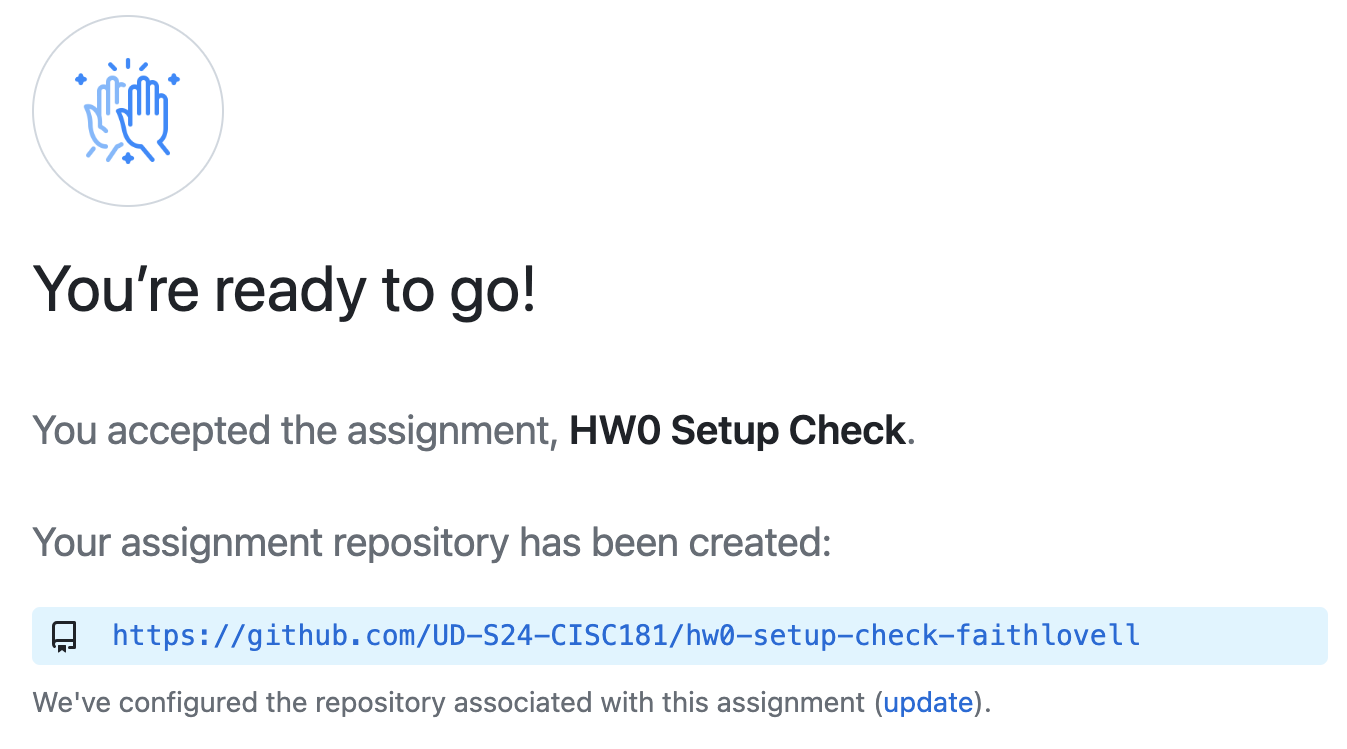
Click the URL for the repository (e.g., “https://github.com/UD-S24-CISC181/hw0-setup-check-acbart”) to access your repository.

Click the green “< > Code” button and a menu will pop out.
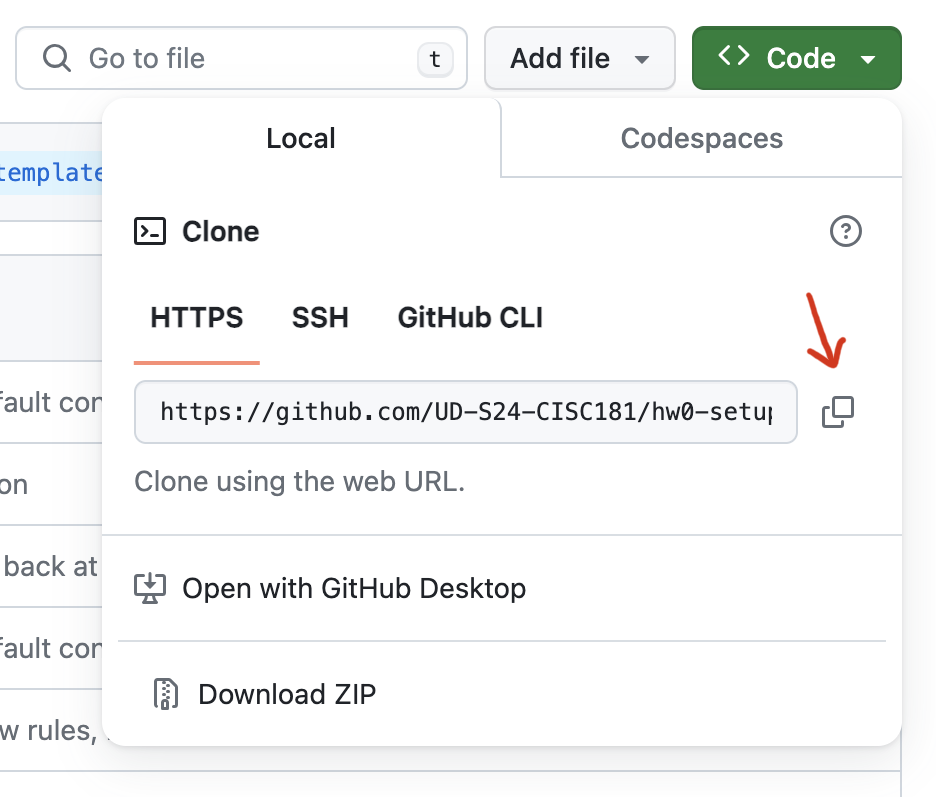
Click the copy button to get the URL of the repository. You will clone this repository in VS Code, in order to get a local copy of the repository that you can freely edit.
You will need to run the “Git: Clone” command in VS Code:
- Type
Ctrl+Shift+P(Windows) orCmd+Shift+P(Mac) to bring up the command palette - Type
Git: Cloneand press “Enter” - Type
Ctrl+V(Windows) orCmd+V(Mac) to paste the previously copied link and press enter - If you are asked to authenticate on GitHub, do so.
- A folder select window will prompt you to “Choose a folder to clone
into." We recommend that you create a "CISC-181" folder in your user directory, and store all your assignments in there. If you select that CISC-181 folder, then a new folder will be created there for this assignment. - When completed, it will ask if you would like to “open the cloned repository.” Click “Open” to open the repository in the current window.
Inspecting the Project
If everything went well in the previous step, you now have the repository downloaded locally and open in VS Code.
There are a lot of files already in this repository, but we only need to look closely at two of them. If the file are not already visible, click the document icon in the topleft of the left navigation bar to see the “Explorer View.”

This shows all the current files in the project. We are most interested in the src and test directories, which can be expanded by clicking on them.

Click on the basic.ts file (NOT the basic.test.ts file), which is located inside of the src folder. This will open up the file in the editor area.

It looks like someone defined and exported a function named addition, which takes in three number parameters and returns a number.
The code in this file is just a function, which will not do anything on its own. We could run the function definition, but we would not see anything happen since the function is not even being called. Let’s try running the project’s tests to see the function in action.
Click on the basic.test.ts file to view the file’s contents:

Note: If you single clicked on the basic.ts, file, then clicking basic.test.ts replaces the file in the current view. To keep the file open even when you click on other files, double click the filename instead.
Oh dear, there appear to be red squiggles in our code, the universal sign of trouble. What has gone wrong?
To find out more details, hover over the first word with the red squiggles (describe) and a message box will appear.

The interface is reporting an error: it Cannot find name 'describe'. It goes on to suggest installing type definitions for a test runner and even offers a command and some Quick Fix actions.
Should you take the advice of the machine? The answer will always be “it depends”. If you know what you are doing and the advice is correct, then you should certainly use a tool like this. But if you are not sure, then you should not run commands you do not understand.
In this case, the system is letting us know that we never installed the necessary modules required to run our program. This is one of the first steps when starting a project - to install the necessary dependencies onto your system. We’ll need to do this every time we clone a new assignment repository.
Install Modules
The next step is to open a terminal that we can run instructions in.
At the top of your VS Code window, click “Terminal” and then click “New Terminal.” You’ve done this before, but this time, you need to be in the assignment directory. VS Code will do this for you.
A new terminal will appear at the bottom of your screen, and it will look something like this (notice you are in hw0-setup-check):

Run the command (without the dollar sign).
$ npm install
Several messages will appear, some of which may look alarming. Just because you see red text does not mean you have errors, though.
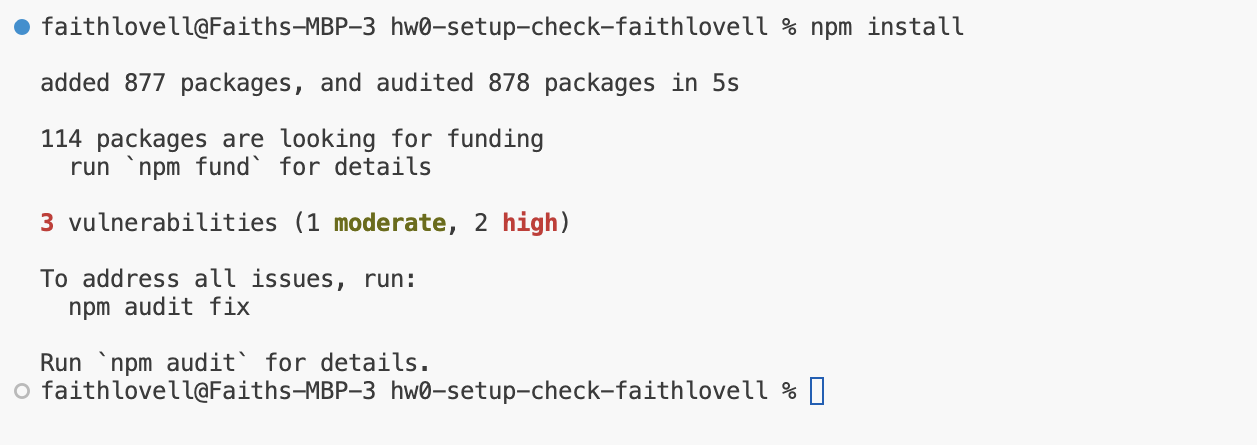
Hopefully, you get a message like the one shown above. It says that it added 877 packages (The number may be different from 877).
The message also says that “3 vulnerabilities” were detected in the packages, and offers a command to fix them. Again, you might be wondering if you should take the advice of a machine. Remember: Do not run commands you do not understand.
Modern TypeScript development requires a large number of packages, even for simple projects. Often, these projects will have small vulnerabilities that are rigorously tracked by the community. If you were going to deploy a website for a large bank or trusted government entity, then it would be very important to address these vulnerabilities.
However, you are a student learning to code. Let’s not get caught up in the security ramifications of our addition function. At least, not yet. We will ignore these vulnerabilities and move back to the code.
Running the Tests
The basic.test.ts file we were looking at before no longer has red squiggles! The code is much easier to read now.
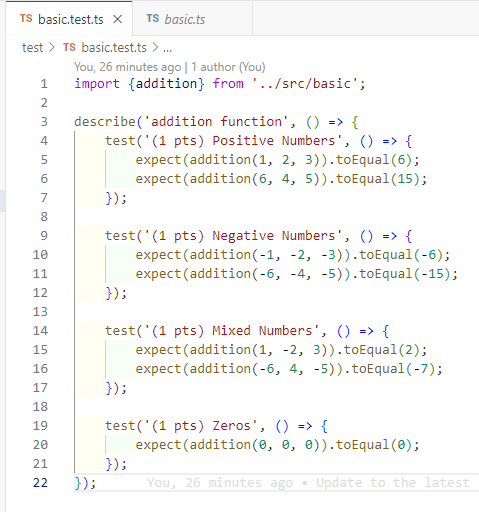
This is a test file written with a library named “Jest.” You have previously seen unit tests written using the Bakery’s assert_equal function, but Jest is a much more sophisticated testing framework. Let’s look at each part of the file in turn.
- At the top of the file (on line 1), we
importtheadditionfunction from thebasic.tsfile, which is in thesrcdirectory. Since that function wasexported, we are able toimportthe function in this file. - The next line of code (line 3) is a call to the
describefunction, which is a Jest function for organizing a suite of unit tests. It takes thestringname of a collection of tests and then an anonymous function that has all the tests inside. Don’t worry about that “anonymous function” term just yet; for now, just think of it as a block of code that Jest will run for us. - The inside of the
describefunction call is a sequence of four calls to thetestfunction (on lines 4, 9, 14, and 19). The test function is another Jest function, once again for organizing related unit tests. We give names to the tests, and sometimes we will also let you know how much that test is worth to us when we grade the assignment. Then there is another anonymous function to have the actual assertions. - On lines 5, 6, 10, 11, 15, 16, and 20, we see the actual assertions, which are equivalent to the
assert_equalfunction you saw previously. In Jest, they are written using theexpectfunction, which consumes one expression (almost always a function call for the function we are testing). The result of theexpectfunction is an object that has atoEqualmethod, which allows us to check the expected result. Again, don’t worry about the terms just yet, just focus on the comparable idea for writing tests between Bakery and Jest.
# Bakery version in Python
assert_equal(addition(1, 2, 3), 6)
// Jest Version in TypeScript
expect(addition(1, 2, 3)).toEqual(6);
The two approaches are basically the same, but Jest has a lot of features for organizing the unit tests. Jest also has a lot of other kinds of assertions, which we might see later in this course. For now, all that matters is that we can see there are 7 tests.
Are we passing the tests? To find out, go back to the terminal and enter the following command (without the dollar sign):
$ npm run test
The output might take a little while the first time, and may be so long that it scrolls offscreen. The final output might look something like this:
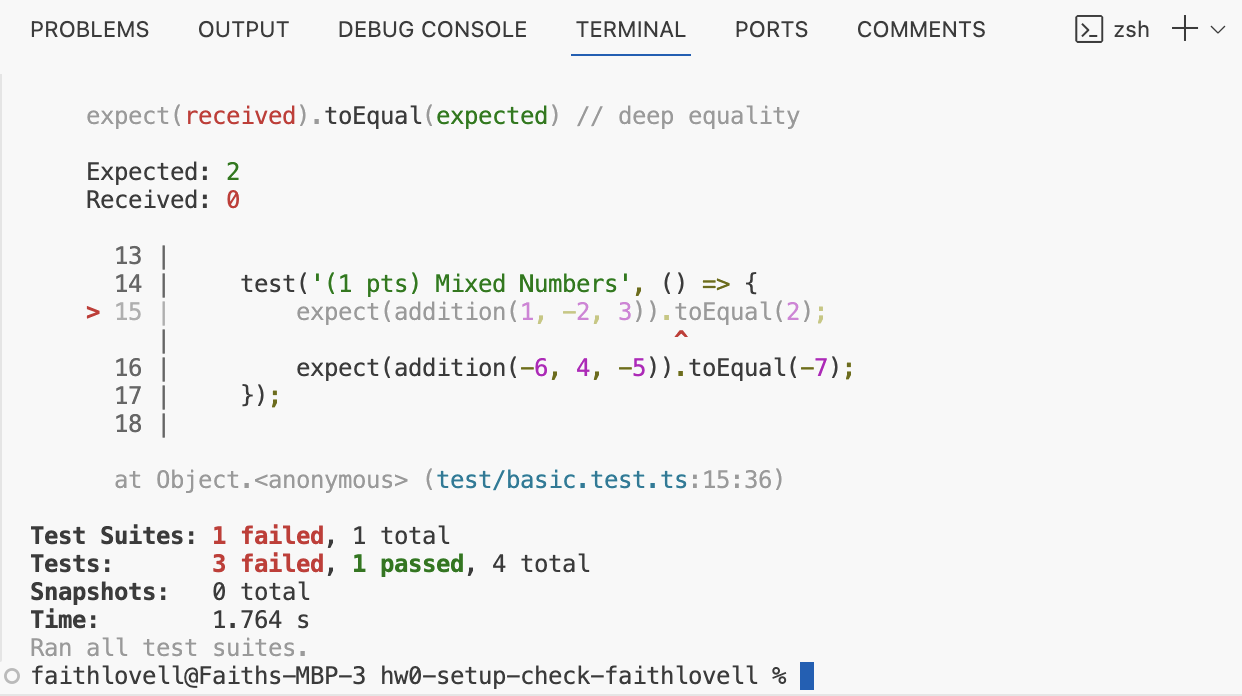
The bottom of the output has a summary of what happened.
- We had one test suite (“addition function”)
- With four total tests
- Three of which failed (“Positive Numbers”, “Negative Numbers”, and “Mixed Numbers”)
- One of which passed (“Zeros”)
Scrolling up through the output, you can see more details about exactly which tests failed and the specific expect assertions that went wrong.
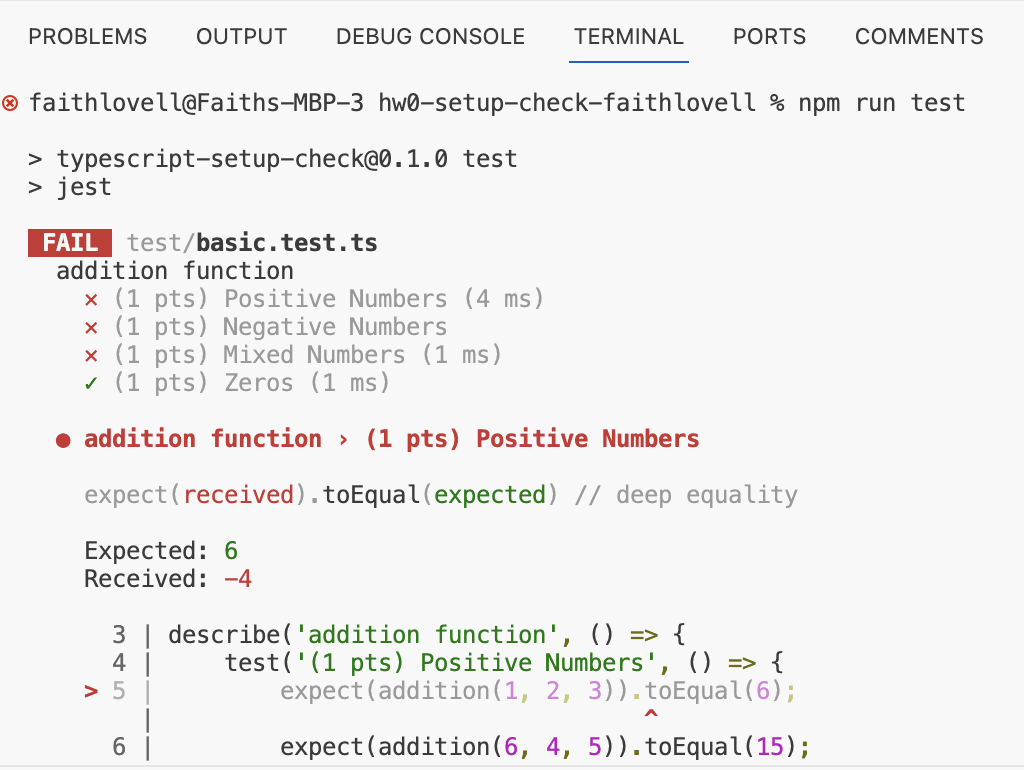
According to the output, the Positive Numbers test called the addition function with the arguments 1, 2, 3 and expected the result to be 6. However, instead the result was -4. There seems to be an error in our code.
Fix the Code
Let us return to our source code file, basic.ts, where the addition function was defined.

There is a new red squiggle waiting for us! We can hover over the squiggle to find out what it is alerting us to.

The feedback from the environment has nothing to do with the correctness of our code. Instead, this is the linter (eslint) complaining about the formatting of our file. Specifically, the system wants us to add a newline at the end of our file.
Sometimes, you may disagree with what the linter says. There are a lot of subjective opinions about how code should be formatted. On a good development team, all the developers will agree on a set of linting rules. However, while you are starting out (and even sometimes when you are established), you may have to live with rules you do not like. In this case, we need everyone to follow linting rules to make our ability to help you more effective. Clean, well-formatted code is much easier to read and debug!
The linter gives feedback through red squiggles in the editor. However, you can also run the linter through the command line, just like we do the tests:
npm run lint
It’s a good habit to run the linter along with the tests when you think you are done, to make sure that you’ve fixed the error. Either way, the issue in this file is the same.
Add a blank line at the end of the file to make the squiggle go away.
However, this does not fix the program. You should look at what the function is doing and think about it for a moment. We will not tell you the error, but you have probably already noticed it. Either way, fix the code now.

You may notice a black dot next to the name of the basic.ts file in the tab. This indicates that the file has not been saved. Save the file now (either using the appropriate keyboard shortcut or the file menu). If you do not fix AND save the file, then the next step will not work.
Run the Tests Again
Now that you’ve fixed the code and saved the file, you can return to the terminal to run the tests again.
$ npm run test
And the resulting output this time should look a lot better.
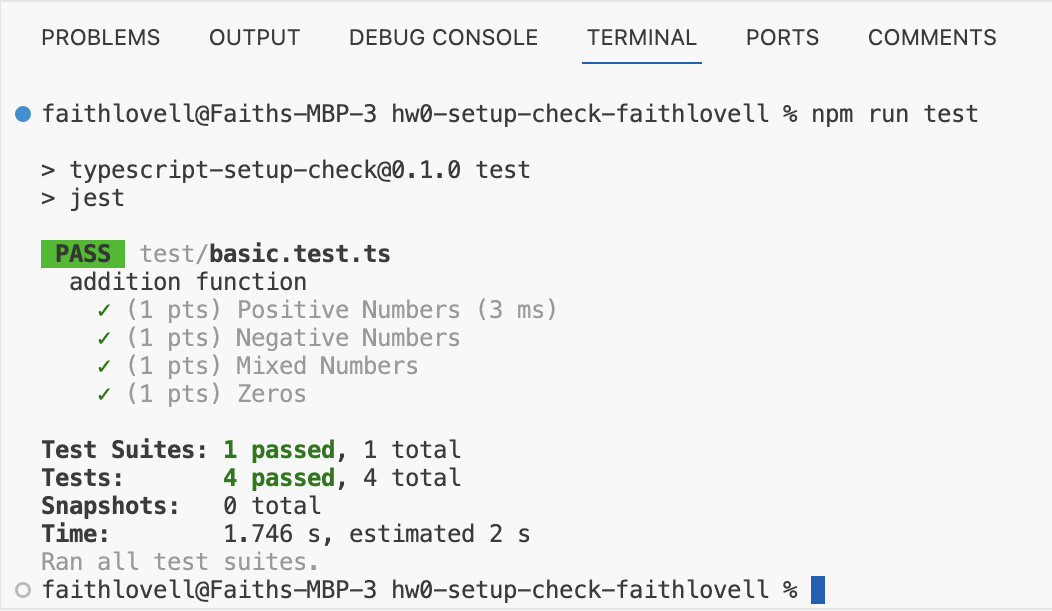
With the code fixed, we are now ready to save our work back to our remote repository.
Stage/Commit/Push to GitHub
Periodically, as you complete portions of assignments, you should stage and commit your work in your local Git repository. This makes a backup of your work locally and also will give us a clear indication of your work timeline. When you are done the assignment, you can push your commits to the remote repository on GitHub.
We will discuss these terms a lot more in lecture, but here are some basic definitions:
- Stage: Mark locally edited files as being ready to save.
- Commit: Save a group of files’ current state along with a message describing the change made to them.
- Push: Move a bunch of local commits to a remote repository.
To stage and commit files, we will use the source control panel, accessible from the left navigation bar.
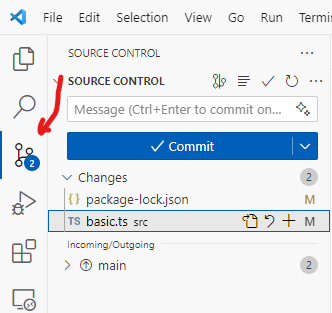
The source control panel gives us a graphical user interface for running Git commands. We could also run them from the terminal, but for now it will most likely be easier to use this interface.
VS Code has identified two files that we have edited: basic.ts and package-lock.json.
You hopefully remember editing the basic.ts file, but what about package-lock.json? That’s a file used by the system to track the installed packages. We updated it when we ran npm install. You don’t need to worry about this file.
Instead, focus on the basic.ts file. Click on the filename in the Source Control panel and VS Code will show you a diff (“difference”).

The dark red line was deleted from the left, so it shows up as a grey hatched line on the right. Similarly, the light red line was modified on the left, so it shows up as a green line on the right. These were indeed the changes we made to the file.
We’re happy with these changes, so the time has come to stage the files.
Click the plus button next to each file to stage them.
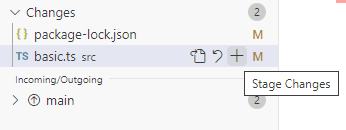
When staged, the files are moved to the “Staged Changes” section and are ready to be committed.

However, first we must write a commit message to explain what we have done. This message should be short, ideally fitting nicely into that box. If someone scrolls through the history of our commit messages, they should have a clear idea of what we did while writing the project.
An example commit message here might be Addition function fixed.
It might have been a better idea to make two separate commits, one for updating the package-lock.json file (“Modules installed”) and then one for just the basic.ts file (“Addition function fixed”). Commits don’t have to be made with all edited files; just the ones you have staged. Deciding on the granularity of your commits is a personal decision, but we encourage you to be fine-grained!
Once you have typed your message, click the Commit button to commit your staged changes.

After committing, the button will change to “Sync Changes,” allowing you to push your commits to GitHub.

Click the “Sync Changes” button, and you will be told “This action will pull and push commits from and to origin/main”. Click “OK” because that is exactly what we want to do.
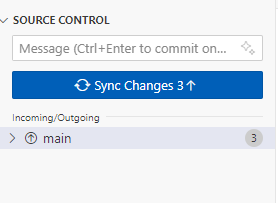
The source control panel will now be partially greyed out since you have nothing left to commit.
“Need to Configure Git”
If you encounter an error like “need to configure git” before you can push, then you can run the following commands in the terminal, substituting your email address and name.
git config --global user.email "YOUREMAIL@udel.edu" git config --global user.name "YOUR NAME"Make sure you replace
YOUREMAILwith your UD Email, andYOUR NAMEwith your name (e.g.,Austin Bart).
If everything went well, you should be able to see your new commit on the GitHub repository website.

We’re almost done. The time has come to submit!
Submitting on GradeScope
At the bottom of the assignment page on Canvas, you will see a box with GradeScope embedded inside (just like BlockPy!). GradeScope is a platform for running student code through instructor unit tests, which will give you automatic feedback and score you.
For this assignment, GradeScope will run the same tests that we gave you. But in future assignments, we may have hidden tests. This helps make sure that you are fulfilling all the parts of the assignment and not just coding directly against the tests we gave you. Make sure you follow all the instructions!
In the box below, click Submit and then choose “GitHub” as the submission method.
The first time you submit your repository, you will need to authorize Gradescope to access your Git repository.
When you click to authorize GitHub with Gradescope, the embedded page may fail to load. If this happens, just open https://gradescope.com, go into the course and assignment (Homework 0- Setup Check), and authorize there. The permissions should work fine in a separate browser tab.
Type the name of your repository and choose it from the dropdown. It should start with hw0.
From the branch dropdown, choose the main branch.
You can submit multiple times before the deadline. Your last submission will determine your grade. For many assignments, we will give you additional feedback beyond what the autograder will give you, so do not assume that your grade will remain as it is. However, if the autograder reports any issues, you should attend to them now!
Summary
Let us review all the steps we took in this assignment:
- Created a fork of the assignment on GitHub Classroom
- Cloned the repository onto your computer
- Installed the project’s modules using npm install
- Ran the project’s tests using npm run test
- Edited the TypeScript source code files for the project in the src/ directory
- Reran the tests to make sure everything worked
- Staged, commited, and pushed the changes to your repository
- Submitted the repository below to GradeScope
- Confirmed that we passed all the autograder tests
This will be the workflow for the rest of the semester, so get used to it!
Next Step
It has been a couple of months since you completed your CS1 course, so let’s review some concepts from last semester.
While Python and TypeScript (and many other languages) are different, the basic concepts we learned in CS1 are still valid.
Concepts such as variables, operators, functions, conditionals and looping might have different syntax but largely operate in the same way between languages.
If you understand the basic concepts, picking up a new language like TypeScript is easier. This is a critical skill as new languages and paradigms come into fashion all the time. Learning how to apply your core knowledge to a new situation is critical to stay current throughout your career as a computer scientist.
Let’s start with Variables »